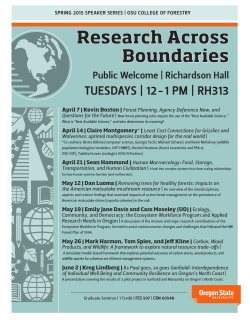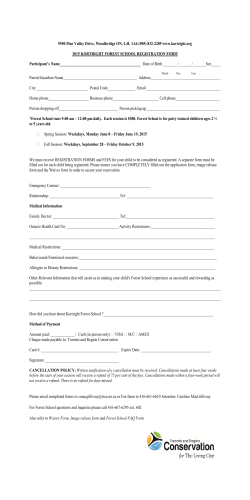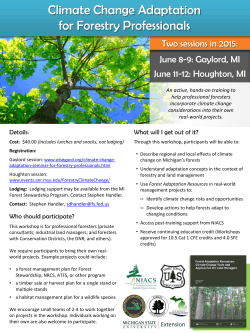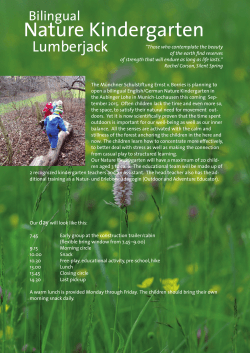
Commercial timber trees of the Malay Peninsula
MALAYAN FORES'r RECORDS NO· 3 • • ercta rees • • ala o Peninsula • By F. W. FOX WORTHY Forest Research Officer, Federated Malay States • Plates by PERPUSTAKAAN £ 34, cy oCf 5'1,5, NEGARAMALAYFO)( SI A LasceHcs & Co. U.d. ~p Lo r~Dn : l. PUBLISHED BY PERMISSION OF THE FEDERATED MALAY STATES GOVERNMENT AN D PRINT ED BY FRASER & NEAVE, LTD., SINGAPORE • • • • • , 1927. No.3. • COMMERCIAL TIMBER TREES OF THE • MALAY PENINSULA. • By F. W. FOXWORTHY, Forest Resea't'ch Officer, F.M.S. INTRODUCTION. The timber trees of the Malay Peninsula are of many kinds and are very imperfectly known. The need of a manual which could be used by forest officers and others as an aid in identifying the more important trees has been very much felt. Such a manual should give, as simply as possible, the identification marks for each kind of tree and should also give a concise summary of what is known about each of the commercial trees. Work of this kind was begun by the late Conservator of Forests, A. M. Burn-Murdoch, who, in 1911 and 1912, published the first two parts of his" Trees and Timbers of the Malay Peninsula." This work was stopped by his death in 1915 and was discontinued for a time. When the work was taken up again, it seemed appropriate to organize it on a more systematic basis and to condense it into one volume of not too large size. This offered some difficulty and it was necessary to eliminate as much a possible. The work has been restricted, almost entirely, to those forms which are considered as commercial timber trees, or which are so conspicuous in appearance as to command attention in the forest, and the descriptive matter has been condensed and presented in a uniform manner. PERPUSTAKAAN NEGARAMALAYSI A • • • Commercial Timber Trees 2 [MAL. FOR. REC. METHODS OF WORK. It was necessary, first of all, to become acquainted with the species producing the different timbers. This was accomplished by as extensive collecting as was practicable. The collection of good herbarium material made it possible to work out the botanical status of the different pecies and al 0 furnished a good deal of information about their natural distribution and habitats. The next step was to determine the relative and actual abundance of the different forms. Several kinds of work were required for this. A large chart was prepared to show the known occurrence of the different commercial timbers in the different districts. Forest officers sent in samples of the different woods from their districts and entries were made on the chart as the pieces were received. Outline maps of the Peninsula were prepared to show the occurrence by district of each kind of tree and each species. Special valuation surveys were done, on a definite percentage basis, of more than one million acres of forest in different parts of the Peninsula. The method of taking these valuations was described in "Forest Reconnaissance in British Malaya" (Empire Forestry Journal, Vol. m., 1924, pp. 78-86), and the details of the different pieces of reconnaissance were presented in a series of special departmental reports. These valuation surveys gave us a good deal of preliminary information, besides showing what were the abundant forms and the amount of timber carried by different areas. The next step was to make a detailed study, in the field, of each of the forms·and to write descriptions containing the results of field studies. It was also necessary to go through the departmental files and get out all of the available information concerning sylvicultural treatment, to compile this information and compare it with the literature of the subject from other countries. Rough descriptions, prepared as a result of the above work, were sent to the different forest officers for criticism. These de criptions were later rewritten embodying the results of the criticisms. Each description in this work has been written at least three times and may be taken as fairly representative of our present knowledge of the form described. PERPUSTAKAAN NEGARAMALAYSI A FORESTS OF THE MALAY PE INSULA. • • Some general statements as to the location, extent, natural condition , and composition of our forests need to be made before proceeding with the consideration of individual kinds of trees . Geography. The Malay Peninsula extends from a little over 0 0 1 to the Isthmus of Kra at 10 N. lat. Its entire length is about • • No.3] • • 3 oj the Malay Peninsula. 700 miles and its greatest breadth about 200 miles. The extent of the Peninsula in longitude is from 98° 20' E. to 104° 20' E. Nearly all , of that part of the Peninsula lying south of 6° N. lat. is under British, and nearly all of the part north of that latitude under Siamese influence. The Siamese portion of the Peninsula has an area of approximately 20,000 square miles. The commercial forms in the Siamese portion are, in the main, the same as those further south, and the distribution notes include the records for this portion, so far as they are known. The political divisions of the Peninsula are, the Unfederated Malay States of Perlis, Kedah, Kelantan, Trengganu, and J ohore, the Federated Malay States of Perak, Selangor, Negri Sembilan, and Pahang, and the Straits Settlements of Penang, Province Wellesley, the Dindings, Malacca, and Singapore. The area of each of these is given in the following table:Area in square miles. Perlis • • Kedah • • Kelantan Trengganu Johore • • • • • • • • • • • • • • • • • • • • • • • • • • • • • • • • 316 3,648 5,713 6,000 7,678 • • Total Unfederated Malay States Perak • • Selangor .. Negri Sembilan Pahang • • 23,355 • • • • • • • • • • • • • 7,875 3,195 2,572 14,006 PERPUSTAKAAN NEGARAMALAYSI A • • • • • • • • • • • Penang • • • Province Wellesley Dindings • Malacca • • • Singapore • • • • • Total Federated Malay States • • • • • • • • • 27,648 • • 108 280 183 720 217 • • • • • • • • • • • • • • • • • • • 1,508 Total for British portion of Peninsula .. 52,511 Total Straits Settlements • 4 Comme1'cial Timber T'rees [MAL. FOR. REC. The total population of these Malay state is omething over 3,300,000, or an average of rather more than 60 to the square mile. Portions of Pahang, Kelantan, and Trengganu are still very sparsely populated. . CLIMATE. There is remarkably little seasonal change on the west coast of the Penin ula; the east coast feel the effect of the monsoon and has more or less pronounced wet and dry seasons. The northern part of the Peninsula has more of s change than has the outhern part. The state of Pahang hows some ariation of . ea on from ea t to we t, but we have very meagre information about the degree of change. Rainfall, in different part, varie from 77 to 220 inches per year. Rains are very localized and occur as brief and heavy howers. All day rains are unu ual, except in Pahang during the wet monsoon. Heavy and prolonged torrential rain, such an i experienced in certain other tropical countrie , i practically unknown, and few places have ever hown a maximum rainfall of more than six inches in twenty-four hours. The temperature i very uniform, the average being about 80° the maximum 96 °, and the minimum 67°, at ea level. Evaporation is very heavy on orne days, but strong winds are rarely experienced and severe wind storms are practically unknown, aUhough small and local whirl winds have sometimes been reported. SOIL AND TOPOGRAPHY. The soils most commonly recognized are, laterite, alluvium, peat, and clay. There are certain portions where limestone is common and there are a number of places where the subsoil contains a clay layer, resulting in the formation of fresh water swamps. The topography is, for the most part, of a very rugged type. Level areas are not extensive, except in swamps. The country in general is hilly or mountainous and the slopes are often very steep. A consequence of this is that the treams are usually short and have small drainage basin. Trees are found growing on steeper lope than i u ually the case in other countries. Erosion is rapid when the cover is removed. The main range is granite, but there are a number of place where there are limestone cliffs. PERPUSTAKAAN NEGARAMALAYSI A EXTE T OF THE FOREST. The area occupied by commercial forest is e timated to be about 30,000 square miles, but considerable parts of this have not • • No.3] 5 of the Malay Peninsula. yet been carefully examined, and the actual area may be less than that given. There are also considerable areas where the original forest has been destroyed and the land is now occupied by the second growth forest known as belukar. COMPOSITION OF THE FOREST. Wealth of species. There are about 2,500 known species of trees in the Malay Peninsula. This is, perhaps, more than are recorded from all of British India and Burma. It is doubtful if we have yet learned as much as 75 % of our species. It is certain that we have many more tree species than are found in India or in Burma, or in the tropical portions of the two countries. The multiplication of species of woody plants is very marked, in the wet tropics, as the equator is neared, and ours is a nearly equatorial location and climate. It is not unusual to find, in the Malay Peninsula, single acres of forest which carry more than 100 species of trees. Much the largest part of these are trees of small size and do not have any present economic value. • CLASSES OF FOREST. Our forests may, for convenience, be roughly grouped as littoral, lowland, and mountain or hill forests, each of which may be capable of a number of sub-divisions. LITTORAL FORESTS . • These may be sub-divided into beach forests and mangrove swamps. Beach forests. These occupy a very narrow strip along the sandy beach and produce very few timber trees. Kayu Ru (Casuarina equisetifolia Forst.) and Penaga Laut (Calophyllum Inophyllum L.) are the only ones of our commercial timber trees that belong to this type of forest. Mangrove swamps. These tidal forests occupy a few hundred square miles and are most important because of the firewood which they supply. They will be treated in a separate pUblication. PERPUSTAKAAN NEGARAMALAYSI A HILL FORESTS. , • • The highest mountains are covered with a very dense, lowgrowing forest cover, made up of very large numbers of species of small trees, very many of which have thick leathery leaves, crooked, much-branched stems, and with large numbers of epiphytes on their bark. This kind of forest is not at present commercial and is not likely to become so for many years. Below this is what • 6 Commercial Timbe1' Trees [MAL. FOR. REC. may be called the mid-mountain fore t, with larger leaves and much better po ibilitie of commercial de elopment. Thi fore t is al 0 not of pre ent economic importance, except in the vicinity of hill tation. :Many of the hill fore t have a very den e undergrowth and the ground i often covered with mall plants and plant remain to a depth of a number of inche. The hill fore ts may be con idered a being all that are aboye an elevation of 2,000 feet above ea Ie el, a line which i cho en arbitrarily becau e it eem to mark the upper limit of what it i practicable to work at pre ent. Fore t above the 2,000 feet level occupy, perhap , 10 % of the total land area of the Penin ula. Their pre ent value i a a protective fore t, preventing ero ion and pre erving stream flow. Ridge forests. A one get into mountainou country, the high ridge tand out very sharply. The e bear a den e cover of large tree on their crests, but are much Ie den ely covered on their ide. The top of such ridge, from 1,000 to 3,600 feet above ea level, often beal' large number of Seraya (Shorea Curtisii Dyer) tree. (See fronti piece). LOWLAND FORESTS. The e begin ju t back of the beach and extend up to the hill type. The dividing line between lowland and hill forest is not sharply marked and certain lowland form arc often found above the 2,000 feet contour. Lowland fore~t may be cla ified, according to drainage, as swamp fore t or high forest, the latter of which i frequently interrupted by patches of belukar. Fresh 1.uater swa1np forest. It i e timated that 10% of the area of the Penin ula i occupied by fre~h water wamps. These vary greatly in depth of water level, relation to drainage, and in the pecie that occupy them. Even the deepe t wamps contain many more or Ie firm pot where tree occur. There i , in some place an accumulation of plant remain to a depth of many feet. Swamp with the greate t permanent depth of water u ually contain no, or few, tree pecie. Slightly more shallow swamps may contain Meranti Bakau (Shorea p.), Punah (Tetramerista glabra :Miq.), Dedaru (Urandra corniculata (Becc.) Foxw.), Kempas (Koompassia malaccensis Maing.), and certain other forms. Lopak. This i a pecial type of wamp forest, which is subject to occasional inundation, but ha a fairly firm soil with mud holes. Such a forest may contain a number of forms which are characteristically found in dry land forest. PERPUSTAKAAN NEGARAMALAYSI A • No.3] oj the Malay Peninsula. 7 Swamps often conkin low ridges of dry land, bearing the usual dry land forms. The name of such a ridge is permatang. There is a great deal of work needed in the study of fresh water swamps, which can receive only incidental mention in this work. . Bel-ukar. This is the name applied to the volunteer growth which covers areas that have been cut over. It is, at first, composed of quick-growing species, which are often short-lived. Later, the seedlings of forest trees find a place and there is a gradual transformation to high forest. It is believed that this change may require about 250 years, under natural conditions. The area of belukar in the Peninsula is not known, but it will run into many thousands of acres, because of the system of shifting cultivation that has been practised by the wild people since very ancient times. There are also many abandoned cultivation areas of more recent date. Such regions, if frequently burned over, may be occupied by lalang (Imperata spp.), a coarse grass which is very hard to eradicate. This grass does not, however, occur in anything like the abundance with which it occurs in some other countries of the eastern tropics. The reason for this is that the uniform high humidity makes fires less frequent; and, if lalang is not burned over at frequent intervals, other plants become established and will, in no very great time, eliminate the lalang. In consequence of this we have no large lalang areas in the southern part of the Peninsula; and, even in the drier parts, lalang is not a serious pest, -so far as occupation of large areas is concerned. • High forest. The mature inland forest is of the type described by Schimper (Plant Geography, Chaps. II. and IV.) as rain forest. It is made up of a very large number of species and includes most of our commercial timber trees. The average height of the top of the crowns is something more than 150 feet and the canopy is very dense. The vegetation is arranged in several storeys. The first, or top, storey is made up of very large trees, whose crowns start at 60 or 100 feet or more above the ground. The trees in this storey are Keruing, Kapur, Meranti, Resak, Chengal, Kempas, Tualang, and J elutong, and occasionally some other forms. All of these are trees which, at maturity, require very full light. The second storey is made up of trees which spread out at a lower height and whose crowns usually begin as low as 50 feet above the ground. Occasionally some of these trees may reach up into the top storey. The third storey is made up of smaller trees whose crowns are below those of the top storey and which usually branch PERPUSTAKAAN NEGARAMALAYSI A • 8 Comme'rcial Timber Trees [MAL. FOR. REC. quite low. Example are Petaling, Dedali, and many forms of Kelat. The fourth torey i made up of much the large t number of pecie. The e are u ually Ie than 60 feet in total height. This storey probably contains more species, by far, than do all of • the other , but very few of the e pecie are of any present economIC importance. Member of the familie Anonaceae, Euphorbiaceae, and Flacourtiaceae are very prominent in this storey. Beneath this are hrubs, low-growing palms and herbs, but the number of herbaceous form on the floor of the fore t is relatively small. The undergrowth contains large number of the eedlings of the species making up the higher storeys and very large numbers of low-growing palms. In many of our fore t regions the mo t con picuou feature of the undergrowth is the bertam palm (Eugeissonia tristis Griff.). This short or stemless palm has large pinnate leaves which make a very dense cover, beneath which it is often very difficult for seedling to thrive. Bertam seems to be our mo t pernicious fo weed. It can be eradicated by repeated cutting back, but thi i expen ive. In some places, other palms are very prominent in the undergrowth, u ually where bertam does not occur. Some of the e are: Pala (Licuala spp.), Salak (Zalacca spp.) , Chuchok (Calamus p.), Pinang (Pinanga spp.), Teronoh (/guanura spectabilis Ridl.) , Daun Sang (Teysmannia altifrons Miq.), Bayas (Oncospe1'ma hon'ida Scheff.), Pinang Rajah (Cyrtostachys Lakka Becc.), Langkap (Arenga Westerhoutii Griff.), and Serdang (Livistona pp.). Rattans and other climbers are con picuou ly pre ent, although there i nothing like the amount of climber development that there i in certain tropical regions where there i a mon oon climate. PERPUSTAKAAN NEGARAMALAYSI A The be very parang. straight undergrowth i quite den e and any fore t officer would fooli h to attempt to go through the forest without a There i u ually a good deal of cutting to be done, if a line is to be followed. Very few trees display the deciduous habit and, when they are deciduous, the period of leaf-fall and the duration of leaflessness are sometimes uncertain. Some of our trees which are known to have a deciduous habit are : Bungor, J elutong, Kempas, Merbau, Nyatoh (one form), Renga , Sena, Sepetir, Simpoh, and Tualang. There are a number of forms not mentioned in this work which are deciduous, but the number of deciduous pecies is relatively very small. of the Malay Peninsula. No.3] 9 Many species of trees carry a large epiphytic flora on their trunks and branches. Trees of the first storey usually have trunks relatively free from climbers, but have a good many epiphytes on their branches. The forest floor is not usually carpeted with a thick layer of leaves and humus, because of the rapid oxidation which take place. In most of the inland forests the leaves are quickly decomposed; but most of our forest soils give a slightly acid reaction. The natural feeling of a newly arrived forest officer upon entering the forest here, with its stral:zeness and amazing complexity, is one of bewilderment. The effect of this wears off as detailed studies of composition are made. Although the number of tree species is so great, the proportion of species which are of economic importance is small. Most of the earlier writers who dealt with tropical forests strongly emphasized the extreme complexity, and it was only within the present generation that studies by foresters showed that, in spite of the great number of species, the greatest part of the volume of timber produced comes from but a few, often closely related, forms. • Our forests are most closely related to those of the Netherlands Indies, Borneo, and the Philippines. Detailed studies in Borneo and the Philippines have shown that the forests in those countries have from 60 to 90 0/0 of their volume produced by trees of onc family, the Dipterocarpaceae. The indications are, from such studies as have been made in the Malay Peninsula, that our forests have about 60 0/0 of their volume of timber in this group . PERPUSTAKAAN NEGARAMALAYSI A • The following table gives a summary of the measurements of all the trees of commercial size on 3,642.8 acres of forest in various parts of the states of Perak, Selangor, Negri Sembilan, and Pahang, and may be considered as fairly representative of the composition of average good forest in the Peninsula. The table is taken from " Forests of the Malay Peninsula, their composition and value", in the proceedings of the second forest conference of the F.M.S., Kuala Lumpur, February 1926. . • • •
© Copyright 2026









